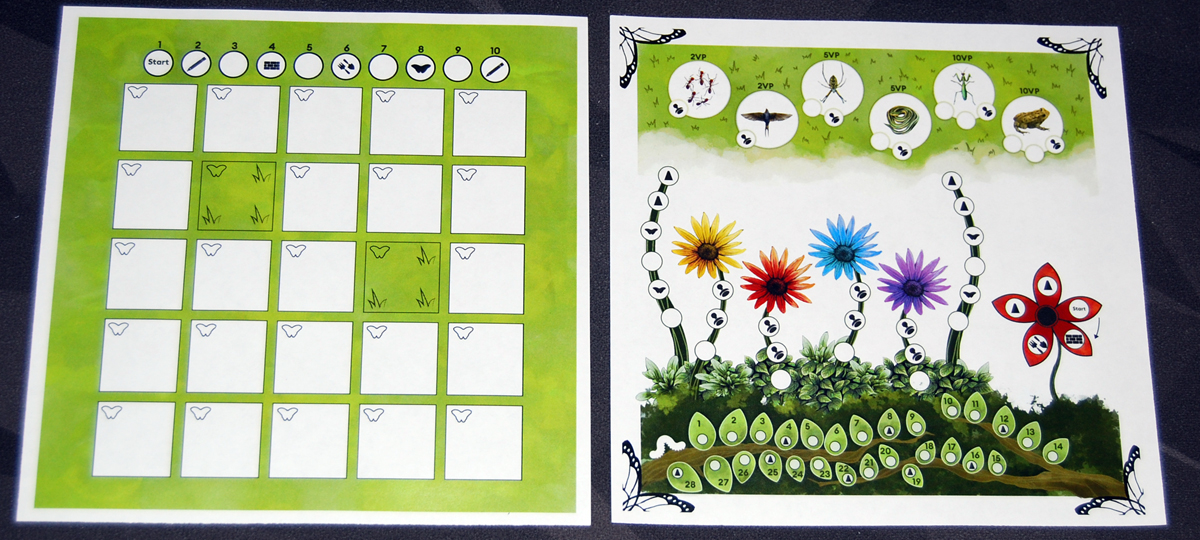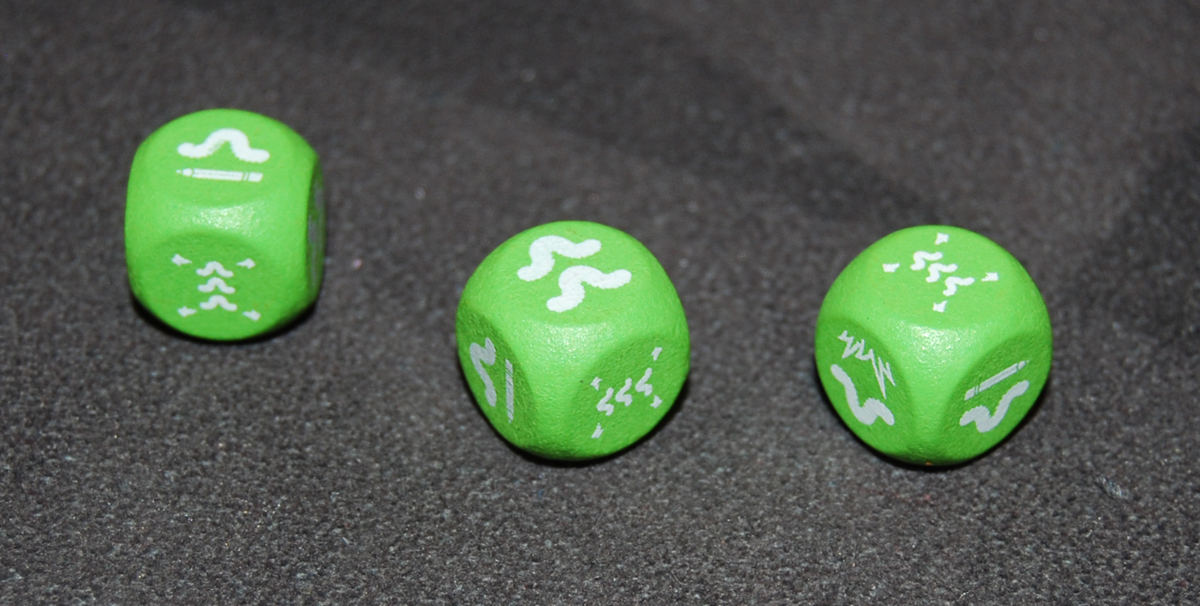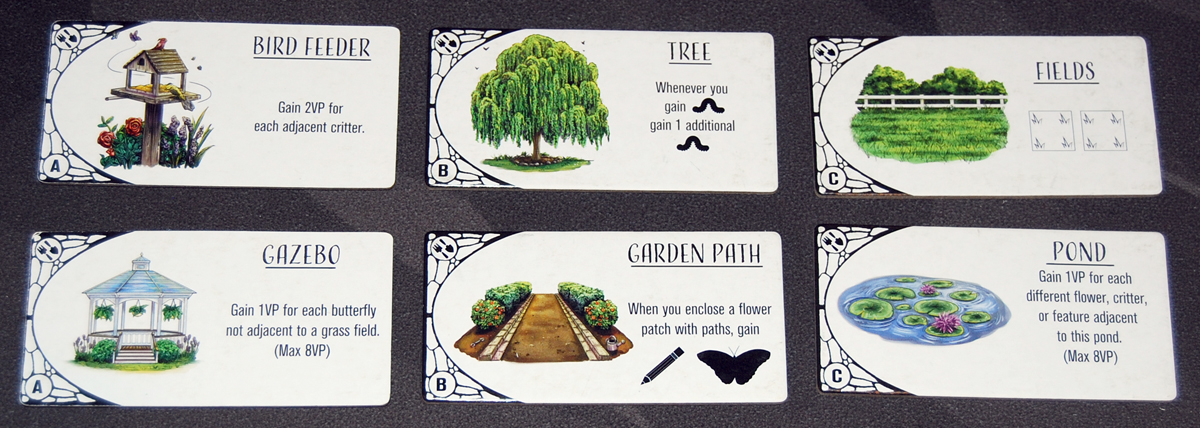
Create a colorful garden to attract butterflies and other critters!
What Is Papillon: Gardens?
Papillon: Gardens is a roll-and-write game for 1 or more players, ages 14 and up, and takes about 30 minutes to play. It’s currently seeking funding on Kickstarter, with a pledge level of $20 for a copy of the game, or $35 for the deluxe copy that includes some fancier stamps and ink pads. (Any number of players can play together—you’re only limited by the number of garden sheets and the ability for everyone to see the set of cards and dice.)
Papillon: Gardens was designed by J.B. Howell and published by Kolossal Games, with art by Chris Byer and Whitney Rader.
New to Kickstarter? Check out our crowdfunding primer.

Papillon: Gardens Components
Note: My review is based on a prototype copy, so it is subject to change and may not reflect final component quality. In particular, the prototype didn’t have all of the feature tiles, and some of the graphic design on the cards has been updated.
Here’s what will come in the box for the standard edition:
- Garden Sheets pad
- Scoring Sheets pad (not pictured above)
- 3 Caterpillar dice
- 4 Flower stamps
- 4 Pencils
- 15 Feature tiles
- 36 Garden cards
The deluxe edition will also include wooden stamps for the flowers, plus 6 critter stamps and a field stamp, as well as 6 ink pads.

The garden sheets are double-sided, and you’ll need one of each side per player. One side shows your garden, a 5×5 grid of squares, along with a turn tracker at the top. The other side is the fill sheet and has various tracks to fill in—critters, flowers, and a caterpillar track, with various bonuses when you reach certain spaces. One note is that the caterpillar track goes left to right on the top row, and then back from right to left on the bottom row—it’s a little wonky and easy to miss if you’re just used to filling from left to right automatically.

The caterpillar dice are quite small (at least in the prototype) and each face shows 1 to 3 caterpillars, with some faces including additional features.

The garden cards each have three important sections: an icon in the top left indicating a type of action, a large image in the center that also provides a particular action, and a small spot in the lower right to place a caterpillar die. The illustrated flowers on the cards aren’t an exact match for the icon flower on the stamps, though the flowers are different enough from each other that you should be able to tell which is which even apart from the color reference. The stamps in the final game may differ somewhat from what you see here.

The feature tiles are small rectangular tiles, and each one has some sort of garden feature: a bird feeder, a hammock, a gazebo. These can be worth points for meeting particular conditions, or give you bonus actions when built.
How to Play Papillon: Gardens
You can download a draft of the rulebook here, or try it out on Tabletop Simulator.
The Goal
The goal of the game is to score the most points by planting flowers, building features, attracting critters, and having butterflies visit the various plots of your garden.
Setup
Separate the feature tiles by type and set out the A tiles, 2 B tiles, 1 C tile, and 1 D tile.
Give each player two garden sheets (one for each side) and a pencil. The garden starts with two fields filled in (the green squares with grass icons)—each player chooses one and marks the butterfly icon to indicate their butterfly’s starting position.
Shuffle the garden cards and make three equal stacks. Place the stamps and dice nearby.
Gameplay
At the start of each round, players mark the next circle in the turn tracker on the top of their garden sheet, gaining the bonus indicated if any.

Then, flip over the top card of each of the garden stacks. Roll a caterpillar die for each card and place it on the card.
Each player independently chooses one of the three sets to use (players may choose the same set). The icon on the card corner provides one of three effects: build two brick edges, build a feature, or mark a space on your fill sheet. Brick edges can help you surround flower patches (contiguous groups of the same color flower) to increase their point value. Features must be placed in empty fields and have various effects—some give you points at the end of the game, and some give you immediate bonus actions.
On your fill sheet, as you mark spaces that have icons in them, you’ll get to take those actions as well. If you complete a critter, you get to add that critter to an empty field space. The flower spaces provide additional flower stamps and other effects. There are also gnome hats on some of the spaces—these give you a choice: stamp a flower, move a butterfly (marking another butterfly icon adjacent to the current one), add a field, add 2 brick edging, or fill one critter space.
The center of the card also provides an effect: often it is stamping one of the four flower colors, but you may also be able to move your butterfly or add new fields (grass) to your garden sheet.
Finally, the caterpillar die indicates how many caterpillars you can mark at the bottom of your fill sheet; some faces also give you an additional mark on your fill sheet, a field space for your garden, or brambles (which overwrites whatever was in a space already).
Note that critters and features must always be placed in a grassy field (if you don’t have any available, you forfeit adding them), and flower stamps must be placed in empty plots without grass.
After everyone has chosen a set and made their marks and stamps on their sheets, start the next round.

Game End
The game ends after 10 rounds. Players score as follows:
- 1 point for each plot with a flower stamp
- 1 point for each flower in a flower patch (at least 3 contiguous of the same color)
- 1 point for each flower patch fully enclosed by brick edging
- 1 point for each plot visited by your butterfly
- Points for each critter (varies by critter)
- Points for features if you meet their conditions
- 3 points for each unique feature in your garden
The highest score wins!
Why You Should Play Papillon: Gardens
The Kickstarter page for Papillon Gardens refers to it as both a “roll and write” and a “stamp and write,” but really it’s a more like a “roll-and-flip and stamp-and-write-and-draw.” The randomized element is provided both by flipping cards and rolling dice, and then you mark your sheets in various ways, from checking off circles to stamping flowers to drawing features and critters.
With only 10 rounds, things are pretty tight and you generally won’t be able to do everything. Each flower stamp is potentially worth up to 3 points—1 base point, 1 point if you can group it with at least 2 other flowers of the same color, and then 1 more point if you can enclose that whole patch with brick edging. The tricky thing is, the bigger your patch, the more bricks it takes to close it off—and if you close off a patch but then get more stamps of the same color, it no longer counts as part of that patch. And, of course, if you’re choosing the brick edge effect a lot, that means you’re sacrificing something else … like maybe stamping some more flowers.
The particular features in play can change up what you might go for, too. The hammock gives you 2 points for each flower patch of a different color, but the statue gives you 4 points for each patch that has at least 5 flowers—one encourages lots of different colors, and the other drives you to focus on fewer colors. The gazebo gives you bonus points for each plot your butterfly visited, so maybe you want to just grab as many “move butterfly” actions as you can.
The caterpillar dice just help to mix up the balance of the cards. Caterpillars earn you gnome bonuses, which provide flexibility, but the faces with more caterpillars also add brambles to your garden, negating a space. Faces with fewer caterpillars can give you bonuses like extra fill spaces or fields. It doesn’t seem like a huge difference, but can tip you toward one card or another.
Papillon Gardens is pretty quick to play—in fact, it sometimes feels like it’s over too soon. If only I could get one more brick edging here, or one more flower in that patch over there! It’s pretty easy to learn as well, and your choices generally don’t feel too overwhelming (but they can still be tricky). If you enjoy roll-and-writes and particularly those that let you be creative, you may enjoy drawing little mantises and fountains on your sheet. (And if not, you might consider the deluxe edition so you don’t have to draw the critters at least!)
I haven’t gotten a chance to play Papillon, the original board game that Papillon Gardens is based on, so I can’t say how similar it feels. The one thing I know is that it had these 3D cardboard flowers and you would put butterfly tokens on them, which gave it a remarkable table presence. Papillon Gardens doesn’t have quite the same wow factor, particularly at the beginning of the game when you all have blank garden plots to fill out, but it does get more colorful as you add flower stamps to your garden. (You can, however, get as fancy as you want with drawing the features.)
For more information or to make a pledge, visit the Papillon: Gardens Kickstarter page!
Click here to see all our tabletop game reviews.
![]() To subscribe to GeekDad’s tabletop gaming coverage, please copy this link and add it to your RSS reader.
To subscribe to GeekDad’s tabletop gaming coverage, please copy this link and add it to your RSS reader.
Disclosure: GeekDad received a copy of this game for review purposes.
Click through to read all of "Kickstarter Tabletop Alert: ‘Papillon: Gardens’" at GeekDad.If you value content from GeekDad, please support us via Patreon or use this link to shop at Amazon. Thanks!

